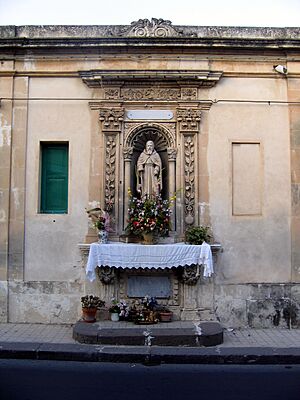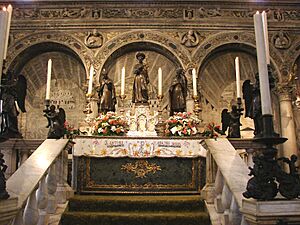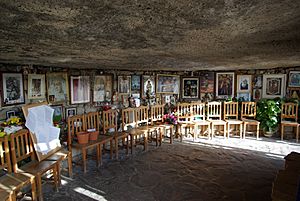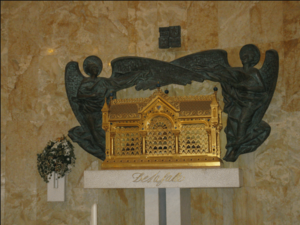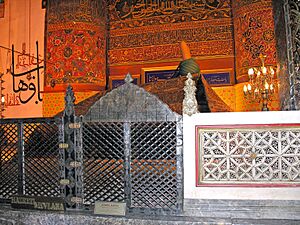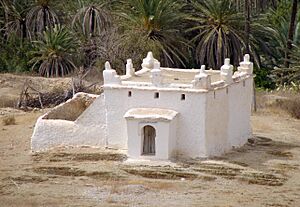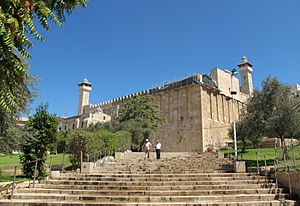Veneration facts for kids
Veneration is a way of showing great respect and honor to someone or something considered very holy. This often includes saints, who are people known for their strong holiness. Angels are also honored in similar ways in many religions. Veneration is practiced in various forms by followers of major religions like Christianity, Judaism, Hinduism, Islam, Buddhism, and Jainism.
In Christianity, groups like the Eastern Orthodox Church and the Catholic Church practice veneration. They have special ways to declare someone a saint. People show veneration by bowing or making the sign of the cross in front of a saint's icon, relics (special objects connected to a saint), or statue. They might also go on a pilgrimage to places linked to saints. Most Protestants and Jehovah's Witnesses generally do not practice veneration. They often believe it is too close to worshipping someone other than God. However, some Lutherans and Anglicans do honor saints, naming churches after them and celebrating certain special days.
Hinduism has a long history of honoring saints, including various gurus and holy teachers. These can be living or deceased. Some types of Buddhism have formal ways to worship saints. Mahayana Buddhism even has different levels of sainthood.
In Islam, some traditional Sunni followers, like Sufis, practice saint veneration. This is common in places like Turkey, Egypt, and parts of Asia. However, other groups, such as Wahhabists, strongly disagree with this practice.
Judaism does not have a formal system for recognizing saints. But there is a long tradition of showing deep respect for important biblical figures and martyrs. Some Jewish communities, especially in Morocco, have a strong tradition of honoring saints.
Contents
Veneration in Buddhism
In major Buddhist traditions, Theravada and Mahayana, people who have reached a high level of enlightenment are called Arhats. Mahayana Buddhism especially teaches that saints can help ordinary people on their journey to enlightenment. Those who have reached enlightenment but choose to delay their own complete peace to help others are called Bodhisattvas. Mahayana Buddhism has special ceremonies for honoring saints. It also has very specific levels of sainthood. Tibetan Buddhists honor especially holy teachers, called lamas, like the Dalai Lama, as saints.
Veneration in Christianity
Honoring holy people started very early in Christianity. Martyrs, who died for their faith, were among the first to be specially honored. Churches officially began remembering saints as early as the first century. The apostle Paul even mentioned saints by name in his writings. Pictures of saints were found in ancient underground burial places called catacombs. The Orthodox Church began official remembrance very early. In Rome, this practice is recorded from the third century. Over time, this honor was also given to Christians who lived very holy lives. Different Christian groups honor and decide on saints in various ways. Some have a formal process to declare someone a saint.
Types of Christian Veneration
Christian thinkers have used specific words to describe different kinds of worship. They use latria for the worship given only to God. They use dulia and proskynesis for the honor given to angels, saints, relics, and icons.
Catholic and Eastern Orthodox teachings also use hyperdulia. This term describes the special honor given to Mary, the mother of Jesus. The Catholic thinker Thomas Aquinas explained that hyperdulia is a higher level of dulia. However, both are still different from latria, which is only for God.
Veneration in Catholicism
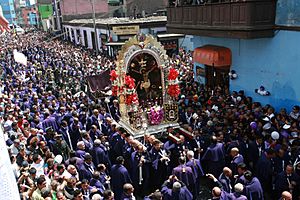
In Catholicism, veneration is a type of honor that is different from true worship. True worship, called latria, is given only to God. According to Mark Miravelle, a Catholic scholar, the word "worship" can mean both adoration (for God) and veneration (for saints).
He explains that adoration, or latria, is the worship and respect given only to God. It shows our submission and dependence on God, who is the creator. Veneration, or dulia, is the honor and respect given to excellent created beings. This means people who have shown great goodness. Historically, the word "worship" was used more broadly. It could refer to either adoration or veneration. So, Catholic texts might use "worship" when talking about the honor given to Mary and the saints, but it does not mean they are worshipped like God.
The Catechism of the Catholic Church teaches that honoring images of saints is not against the rule about idols. It says that "the honor given to an image passes to the person it represents." So, "whoever honors an image honors the person shown in it." The honor given to holy images is respectful veneration. It is not the adoration that is due only to God.
The Catholic Church has a strong tradition of honoring the Virgin Mary. This is studied in a field called Mariology. For the Catholic Church, Mary is known as the Mother of God (also called "Theotokos"). She is also believed to have had:
- The Immaculate Conception: She was born without original sin, by God's grace.
- Perpetual virginity: She remained a virgin before, during, and after Jesus' birth.
- Assumption: She was taken body and soul into Heaven.
These special gifts from God led to her title of Mediatrix of all graces. This means she can help people by praying to Jesus Christ for them.
In the Catholic Church, there are many ways to honor saints. People might go on a pilgrimage to a saint's grave. Examples include the tombs of Saint Peter in the Vatican or Saint Anthony of Padua in Italy. People also visit places linked to a saint's life. Examples are the Cave of Santo Hermano Pedro in Spain or the Cave of the Apocalypse in Greece. Honoring images and relics is also common. Examples include the Lord of Miracles in Peru or the Shrine of the Three Kings in Germany.
Veneration in Oriental Orthodoxy
In the Syriac Orthodox Church, the Hail Mary prayer is said after the Our Father. It is said before the priest enters the special area of the church. The name of the Blessed Virgin Mary has also been used to make altars holy. This is done above the names of all other saints.
Veneration in Eastern Orthodoxy
In the Eastern Orthodox Church, honoring saints is a very important part of worship. Most services end with the words "Most holy Theotokos, save us!" They also use special hymns called Troparions and Kontakions to honor the saint of the day. This practice of honoring saints through praise and their icons is defended in St. John Damascene's book On Holy Images. It was also a main topic at the Second Council of Nicaea.
Veneration in Protestantism
In Protestant churches, veneration is sometimes seen as a sin called idolatry. They believe that declaring someone a saint (canonization) is like making them a god. Protestant teachings usually say there is no real difference between veneration and worship. They claim that veneration takes a Christian's focus away from worshipping God alone. In his book Institutes of the Christian Religion, John Calvin wrote that the difference between dulia and latria was made up. He believed it was created to allow divine honors to be given to angels and dead people. Therefore, some Protestants, like Martin Luther, see veneration as a type of blasphemy. However, some Protestant groups, especially Anglicanism and Lutheranism, do allow for honoring saints. They do this in a way similar to Catholicism.
Bible and Veneration
Some Bible verses are often mentioned when talking about honoring relics of saints.
- "Once while some Israelites were burying a man, suddenly they saw a band of raiders; so they threw the man’s body into Elisha’s tomb. When the body touched Elisha’s bones, the man came to life and stood up on his feet." (2 Kings 13:21, NIV).
- "God did extraordinary miracles through Paul, so that even handkerchiefs and aprons that had touched him were taken to the sick, and their illnesses were cured and the evil spirits left them." (Acts 19:11, 12, NIV).
The deuterocanonical Book of Sirach also talks about remembering important leaders and prophets: "Let us now praise men of renown, and our fathers in their generation" (44:1). "And their names continue for ever, the glory of the holy men remaining unto their children" (44:15).
Support for Veneration
St. Augustine and St. Ambrose, among others, wrote about miracles that happened at the graves of saints. These events happened after biblical times. Such miracles are seen as a sign of God's approval for honoring relics.
Veneration in Hinduism
Hinduism has a long and active tradition of honoring sants (saints) and mahatmas (ascended masters). Sometimes, the line between human and divine becomes unclear for godmen and godwomen. The Bhakti movements made it popular to honor saintly figures. These include sadhus, babas, and gurus. They are seen as examples showing the way to spiritual freedom.
Veneration in Islam
Islam has a rich history of honoring saints, often called wali (meaning "Friend of God"). This practice has become less common in some parts of the Islamic world since the 20th century. This is due to the influence of different types of Salafism. In Sunni Islam, honoring saints became a very common religious practice early on. By the eighth century, saints were defined as "special people chosen by God." They were believed to have special gifts, like being able to perform miracles. Classical Sunni scholars recognized these people as honorable. They were seen as "loved by God and having a close relationship of love to Him." Most saints honored in the classical Sunni world were Sufis. These were Sunni mystics who followed one of the four main Sunni legal schools.
Honoring saints became one of the most common Sunni practices for over a thousand years. However, in the 20th century, the Salafi movement opposed it. They see it as "un-Islamic and old-fashioned." This is different from how it was seen for over a millennium. Similar to the Protestant Reformation, Salafism has tried to stop certain traditional practices. These include honoring saints, visiting their graves, asking for their help, and honoring their relics. As Christopher Taylor noted, "a vital part of Islamic faith was the veneration of Muslim saints." However, due to some ideas within Islam, especially in the 19th and 20th centuries, some modern Muslims have either denied that Muslim saints exist or see their presence and veneration as wrong.
Veneration in Judaism
While Orthodox and Organized Judaism do not formally recognize saints, honoring and visiting the burial places of holy Jewish leaders is an old tradition.
It is common for some Jews to visit the graves of many righteous Jewish leaders. This tradition is especially strong among Moroccan Jews and Jews of Sephardi descent. Some Ashkenazi Jews also follow this practice. This is particularly true in Israel, where many holy Jewish leaders are buried. The Cave of the Patriarchs in Hebron and Rachel's Tomb in Bethlehem are examples of burial sites that attract many visitors. In America, the grave of Rabbi Menachem Mendel Schneerson in Queens is a similar example. During his life, Schneerson often visited his father-in-law's grave. He would read letters and prayers there and leave them on the grave. Today, visitors to Schneerson's grave include Jews from different backgrounds, as well as non-Jews. Visitors usually say prayers and bring written requests, which they leave on the grave.
Veneration in Jainism
In Jainism, they recognize the tirthankaras. These are beings who have achieved spiritual freedom (moksha). They are teachers who showed the Jain path. They do not interfere with the world or events. They serve only as examples to follow. This is shown in their offering ceremonies (devapuja). These ceremonies are more about the believer giving up something than about giving to the tirthankaras. This is because the tirthankaras are completely separate from human affairs. Jains believe they are not affected by them.
See also
- Veneration of the dead
- Intercession of saints
- Mary, mother of Jesus
- Muhammad in Islam
- Rachel's Tomb
- Genuflection
- Patron saint
- Hagiography
- Iconography
- Relic
- Shrine
- Tzadik


